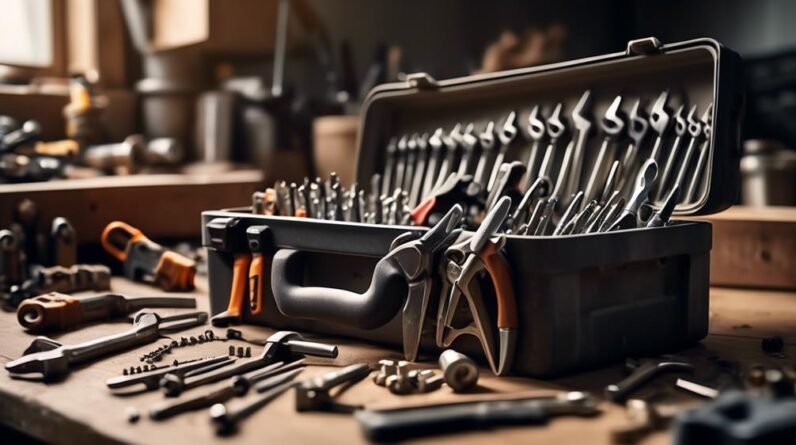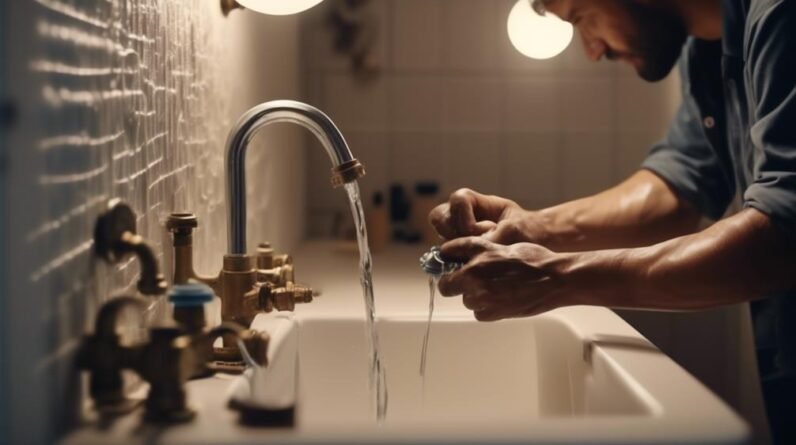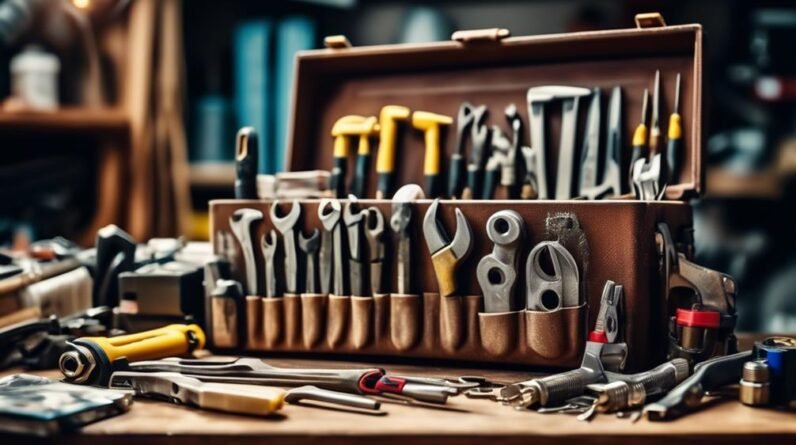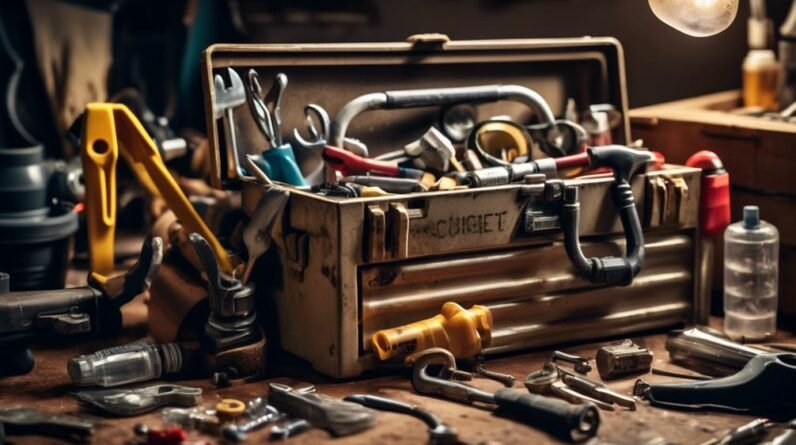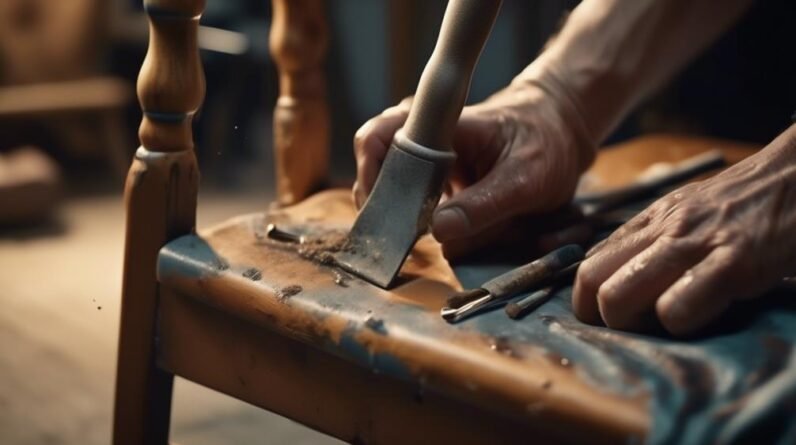
Imagine your home as a well-oiled machine, with each repair and improvement contributing to its smooth operation. Just like a puzzle waiting to be solved, your humble abode may require some attention from time to time. But fear not, for there are affordable DIY hacks that can help you fix common issues without breaking the bank. From fixing leaky faucets to upcycling furniture, this discussion will provide you with practical tips and tricks to tackle those thrifty home repairs. So, get ready to roll up your sleeves and discover the secrets to maintaining a beautiful and functional home.
Key Takeaways
- Fixing leaky faucets can save water and reduce water bills, and it's often caused by worn-out washers.
- Regularly checking for leaks in faucets, toilets, and pipes can prevent further damage.
- Unclog drains using a plunger or plumbing snake, and pour boiling water down drains for preventative maintenance.
- When patching up drywall, assess the damage to determine if it's a small hole or a larger one, and use the appropriate materials and techniques for repair.
Fixing Leaky Faucets
If you have a leaky faucet, there are a few simple steps you can take to fix it yourself and save money on plumbing repairs. The most common cause of a leaky faucet is a worn out washer. To fix this, start by turning off the water supply to the faucet. Then, remove the handle by unscrewing the screw underneath or popping off the decorative cap and removing the screw. Once the handle is off, use pliers to unscrew the packing nut and remove the stem. At the bottom of the stem, you'll find the worn out washer. Replace it with a new one and reassemble the faucet. Another possible cause of a leaky faucet is high water pressure. To adjust the water pressure, locate the shut-off valve on the water supply line leading to the faucet. Turn it clockwise to decrease the pressure or counterclockwise to increase it. Remember, a leaky faucet not only wastes water but also increases your water bill. By replacing worn out washers and adjusting water pressure, you can easily fix a leaky faucet and save money on plumbing repairs.
Patching up Drywall
To continue your thrifty home repairs, let's now focus on patching up drywall, a common issue that often arises after fixing leaky faucets. Drywall repair techniques can be simple and cost-effective if you follow a few key steps.
First, assess the damage. Determine if the hole or crack in the drywall is small or large. Small holes can be easily fixed with a patching compound. For larger holes, you may need to use a patch or piece of drywall.
Next, gather your materials. You will need a putty knife, sandpaper, drywall compound, and a patch or piece of drywall if necessary. These materials can be found at your local home improvement store and are relatively inexpensive.
Now it's time to start the repair. For small holes, apply the patching compound using the putty knife. Smooth it out and let it dry according to the manufacturer's instructions. Once dry, sand the area until it is smooth and blend it with the surrounding wall.
For larger holes, cut a piece of drywall slightly larger than the hole. Use the putty knife to apply the compound around the hole, then press the drywall patch into place. Cover the patch with more compound, smooth it out, and let it dry. Finally, sand and blend it with the surrounding wall.
With these cost-effective drywall patching methods, you can easily repair any holes or cracks in your drywall without breaking the bank.
Painting on a Budget
Painting on a budget can be a cost-effective way to refresh and transform the look of your home. With a little creativity and some thrifty techniques, you can achieve a fresh coat of paint without breaking the bank. One way to save money is by choosing budget-friendly color schemes that require fewer coats of paint. Opt for lighter shades that can make a room feel more spacious and brighter. Another option is to use a color palette that includes neutrals and earth tones, which are timeless and versatile.
In addition to choosing the right colors, there are various creative wall painting techniques that can add visual interest to your space. One technique is color blocking, where you paint different sections of a wall with contrasting colors to create a bold and modern look. Another technique is stenciling, which allows you to add patterns and designs to your walls without the need for expensive wallpaper. You can also try a faux finish, such as sponge painting or rag rolling, to create texture and depth.
Upcycling Furniture
When it comes to thrifty home repairs, another great way to save money and transform your space is by upcycling furniture. Instead of buying new pieces, you can give old cabinets and thrift store finds a new lease on life. Here are some ideas to get you started:
- Repaint and Refinish: Give your furniture a fresh look by sanding it down and applying a new coat of paint or stain. This simple step can completely transform the appearance of a piece and make it feel brand new.
- Add New Hardware: Swapping out the knobs and pulls on your furniture can make a big difference. Look for unique designs at thrift stores or online, and give your old cabinets a modern and stylish update.
- Reupholster: If you have a chair or sofa with worn-out fabric, consider reupholstering it. You can choose a new fabric that matches your style and give the piece a whole new look and feel.
- Repurpose: Get creative and think outside the box. Turn an old dresser into a TV stand or transform a wooden ladder into a bookshelf. The possibilities are endless when it comes to repurposing furniture.
With a little time, effort, and creativity, you can upcycle old furniture and create a unique and personalized space without breaking the bank. So go ahead, unleash your inner DIY enthusiast and give your home a fresh new look.
DIY Plumbing Tips
Save money and tackle plumbing issues yourself with these practical DIY plumbing tips. Regular plumbing maintenance is important to keep your pipes and fixtures in good condition. One simple way to maintain your plumbing system is by regularly checking for any leaks. Inspect your faucets, toilets, and pipes for any signs of leaks, such as water stains or dripping sounds. If you notice a leak, fix it as soon as possible to prevent further damage. Another common plumbing issue is clogged drains. To unclog a drain, try using a plunger or a plumbing snake. Plungers can be effective in removing minor clogs, while a plumbing snake can be used for more stubborn blockages. Remember to always use a plunger with a flat surface to create a tight seal around the drain. For preventative maintenance, you can also pour boiling water down your drains regularly to help dissolve any buildup. By following these simple DIY plumbing tips, you can save money and keep your plumbing system in good working order.
Frequently Asked Questions
Can I Use Household Items to Fix a Leaky Faucet Instead of Buying Expensive Plumbing Tools?
You can definitely use household items to fix a leaky faucet instead of spending money on expensive plumbing tools. It's a temporary fix, but it can work. To prevent leaks, regular maintenance is key.
How Do I Determine if a Crack in My Drywall Is Just Cosmetic or if It Requires Professional Repair?
To determine if a crack in your drywall requires professional repair, examine its size, location, and movement. If it's small, superficial, and doesn't shift, you can use DIY methods like patching and sanding to fix it yourself.
Are There Any Alternatives to Traditional Paint That Can Be Used for a Budget-Friendly Painting Project?
Looking to save money on a painting project? Consider alternative paint options like chalk paint or milk paint. These cost-effective techniques can give your walls a fresh new look without breaking the bank.
What Are Some Creative Ways to Upcycle Furniture Without Spending Much Money on New Materials?
Looking to upcycle furniture without spending much? Get creative with low-cost materials. Try repurposing old fabric or using leftover paint for a fresh look. Inexpensive DIY furniture repairs can give your pieces new life.
Are There Any Safety Precautions to Consider Before Attempting DIY Plumbing Repairs?
Before attempting DIY plumbing repairs, it's important to consider safety precautions. Make sure to turn off the water supply, wear protective gear, and have the necessary tools on hand. Safety first!
Conclusion
In conclusion, these affordable DIY hacks for thrifty home repairs can save you time and money. By fixing leaky faucets, patching up drywall, painting on a budget, upcycling furniture, and utilizing DIY plumbing tips, you can easily address common household issues. With a little effort and creativity, you can transform your home without breaking the bank. So why wait? Start tackling those repairs and enjoy a more functional and stylish living space.


